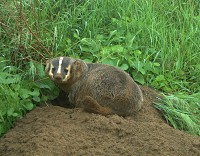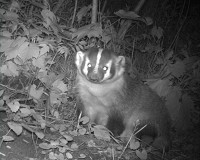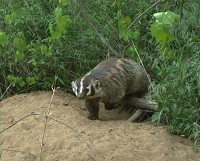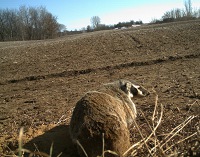What is a Badger?

The North American Badger (Taxidea taxus subspecies jacksoni)

The badger is a solitary and nomadic carnivore

Though occasionally active during the day, they are primarily nocturnal
-2-200x153.jpg)
Badgers don't hibernate, but may remain in their burrows for days or weeks at a time during the winter
The North American Badger (Taxidea taxus) is a medium-sized carnivore in the weasel family. They are stocky animals, with short black legs and a wide body. They generally weigh between 7 kg (15 lb) and 11 kg (25 lb), with males being larger than females. Their coat is a grizzled grey to tawny brown (with other colours mixed in) while their head shows distinctive black and white markings that generally run vertically from nose to neck.
They are solitary and nomadic animals that wander over extremely large home ranges. They use their powerful front legs and long claws to dig burrows for shelter and protection, as well as for hunting their prey. Throughout each badger's home range, it may have hundreds of unique burrows that it, as well as other badgers and even other species, may use. They will rarely stay in any one area for more than a few days before moving on, though they often return to previous locations.
They are primarily carnivores, and will eat a variety of small prey including rodents, frogs and toads, and eggs. They are mostly nocturnal (active by night) but can occasionally be seen during the day. Badgers are polygamous and mate with multiple partners each year. They breed in the late summer and the young are born in the winter. They are not true hibernators, but may stay in their burrows for extended periods during the winter. Despite the name, the North American badger is not closely related to the European badger. Other distant cousins include the wolverine, marten, mink, and honey badger.
Where do Badgers Live?
Badgers can be found throughout much of North America and into northern Mexico. They are most common in the western part of the continent and reach the eastern fringe of their range here in Ontario. There are four subspecies that are separated by slight physiological (as well as genetic) differences.
The jacksoni subspecies is found in southern Ontario as well as in neighbouring Michigan. There are sporadic records of badgers from the far Northwestern region of Ontario, though recent research using DNA has determined that these are actually members of the taxus (Prairie) subspecies. It is estimated that there are fewer than 200 badgers in Ontario, which has led to their being protected under the Endangered Species Act.
Badgers generally prefer open habitat such as meadows and prairies. In Ontario, where we have no large unbroken areas of open prairie, the grassy and weedy edges of fields and forests are the next best thing. This sort of habitat can result as a by-product of farming activities, though it requires relatively non-intensive farming to create enough of these thin strips to support badgers. Another key feature in where badgers are found in Ontario is the amount of "edge habitat" where two distinct habitat types meet, such as a field and forest. Norfolk County and much of the surrounding area are good examples of where the particular mix of farming and natural landcover creates habitat that badgers can use.
What do Badgers Eat?
Badgers are carnivores, like other members of the weasel family. They feed mainly on small mammals such as chipmunks, groundhogs (also known as woodchucks or gophers), rabbits, voles, and mice. However they are fairly opportunistic in their choice of prey and will also eat frogs and toads, eggs, insects, and likely carrion (such as road-kill). They have been documented climbing steep banks to dig out and raid the nests of swallows and kingfishers. They don't seem to have the taste for garbage that raccoons and skunks do and tend to stay farther from populated areas.
Badgers often fill the role of a top predator, and can help to regulate populations of the rodents and other small animals that they eat. Because badgers often bring prey back to their burrows (particularly when the females are raising their young) other animals such as raccoons and foxes may visit in the hopes of finding scraps to scavenge.
Badgers are well known for their ability to hunt burrowing mammals, particularly in the West, where colonial ground squirrels are quite common. They can dig incredibly fast in pursuit of prey and often enlarge the burrows of the animals they hunt faster than their prey can escape. Badgers have even been observed plugging one entrance while digging into an alternate entrance to corner a prey animal, making them one of the few non-primate animals ever observed to use tools.

Chipmunks, like the one this female is bringing her kit, may be the badger's favourite food in Ontario

This female badger killed a groundhog to feed to her "kit"

Badgers will eat the eggs of birds (such as turkeys and ducks) and turtles
-2-200x150.jpg)
Badgers are one of the few animals known to eat skunks

Badgers will also eat frogs, toads, and snakes when they get the chance
The Wandering Badger...

The badger usually moves to a new burrow every few days

Badger home range size in Ontario is extremely large — up to 330 km2 for a single badger

Nightly badger movement spikes during the late summer when both male and female badgers move large distances to find mates
Nearly all of a badger's activity takes place at night. This is the time when they do most of their hunting, as well as travel between burrows. For most of the year, the distance travelled each night is rather modest &mdash between 1 to 5 km. But in late summer, during their breeding season, their activity ramps up in a big way as both males and females will travel large distances to locate mates. The greatest known distance travelled by one badger in one night in Ontario is 14 km. As impressive as that is, a radio-tagged badger in B.C. was found to travel the same distance in just 4 hours!
Over time, this adds up to a very large home range size. In Ontario a single male badger was tracked across an area of 330 km2 (80,000 acres) in less than two years, and a badger in B.C. was found to have an even larger home range of 500 km2. This is in very sharp contrast to badgers in other parts of North America, where home ranges can be as small as 5 km2. It is thought that habitat quality and prey availability are the main factors influencing how much area a badger requires. So while it's truly remarkable that an animal of its size can cover that amount of area, it might be a sign that suitable habitat and/or prey in Ontario are in short supply.
Reproduction
Badgers mate in the late summer and early fall. Both males and females may seek out multiple partners each year, travelling large distances to the far reaches of their home ranges to increase the likelihood of encountering mates.
Because of a process called "delayed implantation", the embryo does not start to develop until the winter. Several other members of the weasel family (such as mink) also reproduce in this manner, and it's thought to be a way to allow an animal to reproduce only if conditions are suitable for raising young. In other words, if food has been scarce and the female is not in the best condition, the embryo may simply not develop that year at all. The males do not assist with raising the young.
A litter of 1 to 5 young, called "kits", is born inside a burrow in the early spring. They spend several weeks in the burrow while the mother badger feeds them &mdash first with milk, and later by bringing back various animals she has hunted. By late spring the mother will move them to a new burrow, carrying them in her mouth if they are too small to walk on their own. Before too long, mother and kit(s) are moving to a new burrow every few days. For most of the summer, the mother still does the bulk of the hunting, while the young wait back at the burrow for her to return. As they get older and more brave, they will spend more time outside of the burrow during the day as well, playing and exploring. This also puts them at greater risk, since they are both small and naive, and their mother can't protect or warn them of danger from deep inside the burrow.
By late summer the young have matured enough to head out on their own. In southern Ontario, this seems to occur around the beginning of August. In a period of just a week or two, the young badgers will go from being dependent on their mother, to entirely self sufficient. The process of the young leaving to find their own territories is called "dispersal". For adult female badgers, this also marks the beginning of the next breeding season.

Young badgers are born underground in the winter but by late spring the mother badger will start moving her young to new burrows

Two young badgers waiting patiently at the burrow for their mother to return with food

It doesn't take too long before the young badgers feel brave enough to venture outside to sun — if only in the presence of their mother

Young badgers are a lot like the young of many animals (and people): full of energy and often irritating to their parents

In the early summer, the young may spend much time outside of the burrow during the day, while the mother is sleeping.



































